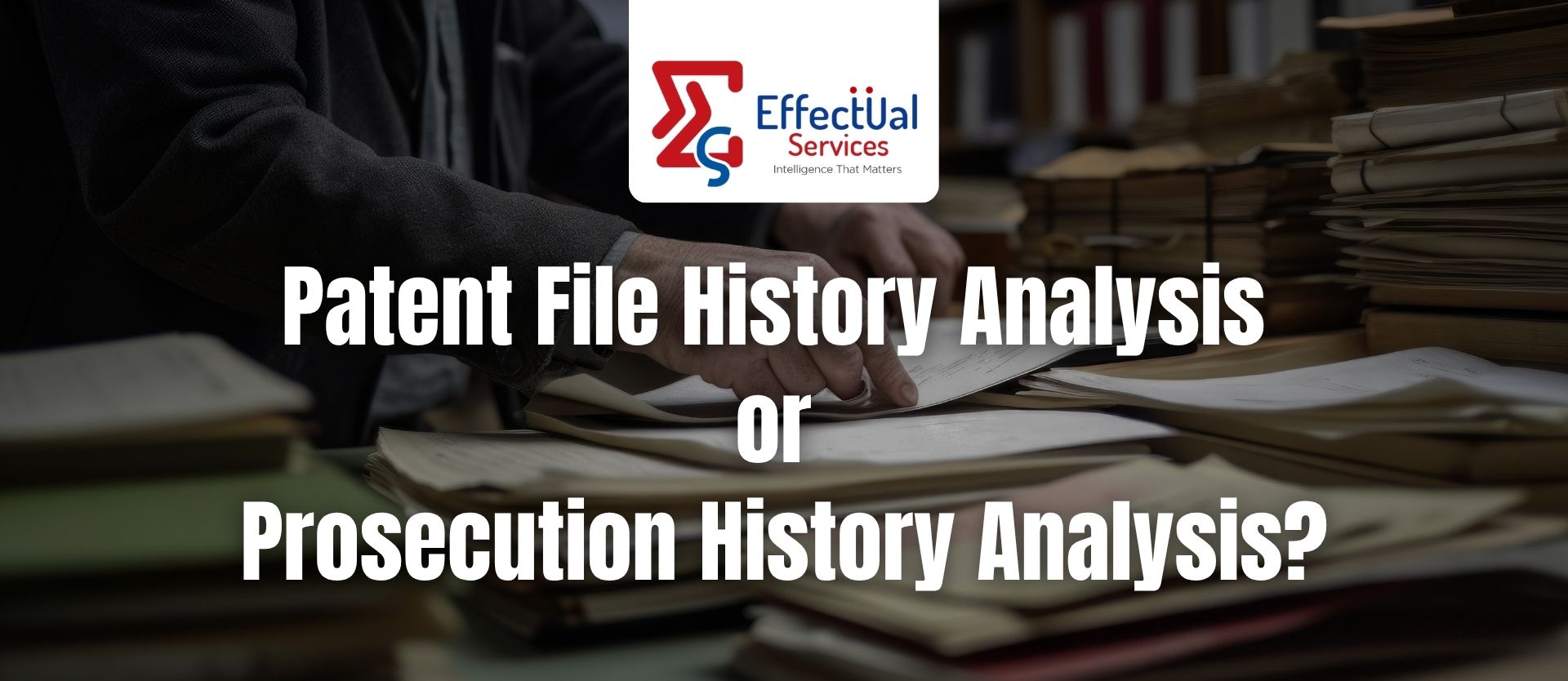What is Patent File History Analysis or Prosecution History Analysis?

What is Patent File History Analysis?
A patent file wrapper or File History is an official record related to prosecution history, giving a view of office actions, prior arts and reason of allowance. The history includes all the documentation of patent application and provide a timeline of a patent application.
The file wrapper estoppel is a doctrine that limits the extent to which a patent can be broadened by the doctrine of equivalents which means that the patentee cannot use equivalents to expand the claim scope in an infringement action in a way that is inconsistent with his position on claim scope before the Patent Office as reflected in the patent file wrapper.
The file wrapper includes communication/arguments between inventor/ patent application representative with the patent office examiner.
Apart from the communication, the provisional document, claims, abstract, specification, references cited by examiner, references cited by applicant and considered by examiner, examiner search strategies, Rejections and amendments after considering the rejection, request for continued examination (RCE), IDS, Oath and declaration, Notice of allowance are also disclosed in the file wrapper.
Step-by-Step Process
Step 1- Download All the Documents
Firstly we gather all the information for File History from the USPTO. It means all the data and documents from the start till the end of the journey of a Patent.
It includes: Original Application, Office Actions, Applicant’s Reply, Claim Changes, IDS, Interview, Notices, RCE’s, Petitions- basically everything related to the case for prosecution record.
Step 2: Gather and Review Client Communications
We keep a record of all the client communications and review them which helps us to understand:
- Internal instructions or strategy discussions
- Business context (e.g., enforcement, licensing, FTO)
- We align our analysis based on what matters most to the client.
Step 3: Organize the Documents Chronologically
- We arrange all documents in the order they were filed or issued.
- Helps us build a clear and accurate timeline.
- Makes it easier to trace how the case progressed from start to finish
Step 4: Highlight all major events
A Patent goes through different stages, we track all the important events which helps us to :
- Figure out any delays or things that didn’t go as expected
- See how one step led to the next. For eg- How a response is filed after rejection
- Understand whether the claims were improved or made more limited
- Know what all led to granting of a patent and not if not, why wasn’t it granted.
Step 5: Review Office Actions
Once an Office action is received we read every rejection, objection, or comment of the examiner and then we focus on: Rejection types like (§101, 102, 103, 112), Which Prior art was cited, Examiner’s reasoning. This helps us understand the challenges faced during examination.
Step 6: Analyze Applicant Responses
We go through how the applicant has responded to the examiner’s concerns and check if the responses actually worked. We focus on:
- What arguments were made
- Whether any claims were changed or updated
- What legal points or clarifications were added
Step 7: Track Claim Evolution
We compare original claims with amended and final versions and record:
- What was added, deleted, or reworded
- If scope was narrowed or clarified
- This shows how the protection changed over time.
Step 8: Check Procedural and Legal Aspects
We Identify disclaimers, restriction requirements, continuations, RCEs, or missed deadlines.
Step 9: Summarize Results with Client Focus
We prepare a report that brings everything together. It includes:
- A clean timeline
- Prosecution challenges and how they were resolved
- Key examiner notes
- Final allowed claims and their scope
- Any red flags or legal concerns
Significance and Importance
1. It contains all the data related to the prosecution history
File history keeps a record of what was filed, what all was rejected, communication/arguments between inventor/ patent application representative with the patent office examiner, the rovisional document, claims, abstract, specification, references cited by examiner, references cited by applicant and considered by examiner everything.
2. It helps in case of any future infringement
File wrapper or File history works as an official record and can be presented as a proof in front of the court in case of infringement and helps to determine a legal outcome.
3. It gives you an edge over competitors
Whether defending your own patent or analyzing someone else’s, knowing the file history helps you see its real strengths and weaknesses. It’s a key tool in patent strategy.
4. It prevents stretching the truth
If the inventor narrowed a claim to get past a rejection, they can’t later argue it means something else. The file history holds them to what they said — and courts take that seriously.
Methodology
- We collect everything: We start by gathering all the documents — the original patent application, office letters, changes made, and anything else sent or received during the process.
- We read through it in order: We look at how things happened step by step — what the inventor asked for, how the patent office responded, and what got changed.
- We focus on the claim changes: If the inventor had to change the wording to get approval, that tells us a lot about what the patent really protects.
- We look at other patents mentioned: These help us understand what was already known and how this invention is different.
- We pay attention to what both sides said: We read what the inventor explained and what the examiner said back. This helps us see what was important during the process.
- We put it all together: Once we’ve reviewed everything, we get a clear picture of what the patent covers — and what it doesn’t.
Our Approach
Effectual Services offering IP support solutions to Fortune 500 companies, law firms, research institutes and universities, and venture capital firms/PE firms. Our teams consists of multi-disciplinary experts with rich experience in handling complex patent related services lie invalidity Searches and also provide other post grant services. Further, we have a Flexible and customer-oriented engagement process.

Case Study
The Situation:
A client came to us worried that a competitor was selling something very close to what they had patented a few years ago. Before doing anything legal, they wanted to be sure their patent actually covered the competitor’s product.
What We Did:
We pulled the full file history of the patent — every document, every back-and-forth with the examiner, and every change made along the way. When we read through it all, we saw that the claims had originally been broader, but the inventor had narrowed them during prosecution to get around a previous invention. That change made the final claim much more specific than it seemed at first glance.
What We Found:
Once we looked at the details, it became clear that the competitor’s product didn’t actually fall under the final version of the patent. The narrowing done earlier made a big difference.
The Result:
Instead of heading straight into a legal battle, the client saved time and money - and avoided a fight they probably wouldn’t have won. They also learned how important it is to review the file history before making any moves.
Frequently Asked Questions
Q1. What is file history?
It is an official record related to prosecution history, giving a view of office actions, prior arts and reason of allowance. The history includes all the documentation of patent application and provide a timeline of a patent application.
Q2. Why is it important?
It shows what all was approved, what was changed, and why. It helps to know what all your patent covers and what not.
Q3. Can it help in a legal case?
Yes. Lawyers and judges look at the file history to figure out what the inventor agreed to as it can be used as an official record. That can play a big role in how a patent is enforced.
Q4. Does this apply outside the U.S.?
Yes, in many cases. Countries like Europe, Japan, and others also keep patent histories. We review those too if needed.
Why Choose Effectual Services?
- We treat your work like it’s our own.
When you hand something over to us, we don’t take it lightly. We go through it carefully and give it the attention it deserves. - We don’t miss the little things.
Even a small detail in a file can change everything. That’s why we double-check and dig deeper to make sure nothing slips through the cracks. - You’ll never be left guessing.
We proactively update our clients. Straight answers, no confusing technical terms. - We are easy to work with.
No delays, no excuses. Just honest work, done on time. - People come back to us — and that says a lot.
Most of our clients have been with us for years. They trust us because we show up, do the work right, and make their lives easier.
Client Testimonials
“It has been a privilege working with Effectual services for an extended period and continue to be astounded by the standard of their services. I wholeheartedly recommend Effectual Services and their services.”
“We have been working with Effectual services with years and have been delighted with our experience. Their communication and responsiveness is just great. They give precise and perfect quality work.”
“Much thanks for connecting. Your correspondence, immediacy and exploration abilities were perfect. No awful input. You have found incredible workmanship which is helpful to us.”
“Working with Effectual Services has been a breath of fresh air. They’re fast, reliable, and actually understand what we need — without us having to explain it twice. They’ve become our go-to team for patent support.”
Solutions Driving Innovation & Intelligence
Enabling Fortune 500's, R&D Giants, Law firms, Universities, Research institutes & SME's Around The Globe Gather Intelligence That
Protects and Nurtures Innovation Through a Team of 250+ Techno Legal Professionals.


